Four battles of "Glory", or Efficiency of mine-artillery positions (part 5)
First and most important: in connection with the presence of the Russians only one battleship with long-range guns (“Glory”), the head of the Naval Forces of the Gulf of Riga, M.K. Bakhirev did not have the opportunity to interfere with the work of two groups of minesweepers simultaneously. By concentrating fire on the minesweepers, who were breaking through the 1917 minefield from the west, he was forced to leave the ships that had bypassed this minefield from the east to be unshot. And for the most part they have done their work.
In fact, this work was greatly facilitated by two circumstances. The Germans had a map of minefields, taken by them on the destroyer “Thunder” (yes, the one who “heroically blew up” sailor Samonchuk. However, there can be no complaints about him himself - this history He did not invent it). And - the carelessness of the remaining unknown persons who have forgotten to remove the buoys that marked the edge of the minefield.
Secondly, the nasal 305-mm installation failed on the "Glory". The reason is the marriage of the Obukhov plant, which “casually made teeth out of bad metal,” as a result of which the locks of the guns were not closed. They tried to repair the damage, but “despite the intensive work of the tower servants and mechanics from the ship’s workshop, nothing was done.” Thus, by the decisive moment of the battle, the Russians had two long-range guns against twenty Germans.
Ships M.K. Bakhirev before the battle began as follows.
“Citizen” was the porcelainiest of all, “Bayan” to the north by two cables to the north, “Glory”, even to the north, almost on the Kuivast road. On "Glory" they decided to take a position closer to the enemy and made a move by stern (it was not safe to turn around at the narrows of the Big Sound) going down to Werder’s Island (dotted arrow).
In 11.30 M.K. Bakhirev ordered the ships to anchor. This was done only by the “Citizen” and “Bayan”, and the “Glory”, with riveted anchor chains, could not fulfill the order of the Vice-Admiral. At the same time, the Germans were preparing for a breakthrough. They strengthened the group of minesweepers to 19 ships, and now everything depended on their crews - if they could withstand Russian fire enough time to clear the fairway for their battleships.
Fight 11.50 - 12.40
The classic description of the beginning of the battle looks like this. In 11.50, on the Russian ships, the minesweepers noticed, and M.K. Bakhirev ordered to be removed from the anchor, which was done, however, they delayed a bit on the “Bayan”. From the flagship cruiser semaphore reported:
However, the distance for the guns of the “Citizen” was still too great, and he was forced to descend to the south, towards the enemy. Then the battleship turned left side to the enemy and opened fire. "Glory" was still completing its maneuver, moving back to Werder Island, and was able to join the battle, firing minesweepers from a distance close to the limit (112 KBT) only in 12.10
But it was too late. In 12.10, German battleships entered the trodden, buoyed, fairway and, adding speed up to 18 nodes, rushed forward. In 12.13, the leading Koenig, having reduced the course to 17 nodes, opened fire when opponents were separated by 90 cables.
Everything seems to be simple and clear ... until you pick up a map and start counting.
It would be logical to assume that the “Citizen” opened fire on the minesweepers with 88 cable for themselves, perhaps a little earlier or later, for the calculation we will accept 85 KBT. It is unlikely that German minesweepers were slower than 7 nodes or faster than 12 nodes. In this case, in the 6 minutes elapsed since the first shot of the “Citizen” (12.04) and before the opening of the fire with the “Glory” (12.10), they passed the 7-12 cable and were located from the “Citizen” approximately in 73-78 KBT. If we take for granted that Glory opened fire while being on 112 cable from minesweepers, it is easy to calculate that at that moment it was separated from the order of 34-39 kbt from the former Tsesarevich.
Alas, it is impossible geographically. In order to move away at such a distance, the “Citizen” had to descend very strongly to the south, having gone beyond the line of booms, which he obviously did not do. But even if you ignore the geography and take the statements of the sources for granted, it turns out that “Koenig” opened fire on the “Glory” with 90 KBT, when it was separated from the “Citizen” by some pathetic 51-56 cables! Is it possible to imagine that the Germans let the Russian battleship so close to themselves without opening fire on it?
Again, if Glory opened fire on the minesweepers in 12.10 with 112 KBT, and König in 12.13 (well, or in 12.15 according to Russian data) - in Glory with 90 KBT, then there is one of two things: or “König” overtook the minesweepers, which is absolutely impossible, or these very minesweepers in order to stay ahead of the “König”, suddenly grew wings (underwater?) And overcame 3 cable for 5-22 minutes, that is, developed 26,5-44 nodes!
Suppose the Koenig opened fire not when the distance to the Glory was 90 KBT, but when the 90 cable was to the nearest Russian ship, that is, to the Citizen. But then it turns out that “Koenig” shot at “Glory” with 124-129 cable (90 kb from “König” to “Citizen” plus 34-39 kbt from “Citizen” to “Glory”)! Of course, such exploits of the König gun, which most likely had a real range of no more than 110 kbt, were obviously incapable.
In order to understand all these intricacies, we need to work in the archives and need documents from the German side, but, alas, the author of this article does not have anything to do with it. It remains only to build all sorts of hypotheses: one of them, in no way pretending to be the ultimate truth, is offered to your attention. It is based on the following data.
The first. Vinogradov, giving perhaps the most detailed description of the October 4 battle, writes about "Citizen":
If the “Citizen” had opened fire at the maximum distance for him (88 kb), then there would be no point in firing at 6-dm guns - their range hardly exceeded 60 kb. This means that, most likely, the “Citizen” opened fire from a much smaller distance, from which 152-mm artillery could hit the enemy.
The second. We also read from Vinogradov, who was studying the magazine of the flagship German battleship, that the shooting of “Glory” was conducted between 12.12 (typo? In other places, Vinogradov gives 12.13) to 12.39, while the distance at that time changed from 109 to 89 cable. That is, “Koenig” opened fire, when before “Glory” it was 109, not 90 KBT.
Based on the above, the author assumes that on the ships of M.K. It was too late for the German minesweepers to find Bakhirev when they were close enough to the Russian ships. The “citizen” descended to the south not in order to shoot 305-mm cannons, but in order to be able to put 152-mm artillery into action. As for “Glory,” she opened fire on the minesweepers not from 112 cables, but from a smaller distance. The battleship entered the battle only after it reached the position near Werder Island (12.08) and led the enemy to the heading angle 135 degrees (which could take 2 minutes).
If the author is right in his assumptions, the beginning of the battle looked like this.
Enemy minesweepers were spotted at 11.50, and the ships began to be removed from the anchor, and the “Bayan” was delayed, and the “Citizen” went down a little to the south to bring into action not only the main, but also the medium caliber.
In the 12.04, “Citizen” from a distance of the order of the 70 cable opened fire with 305-mm guns and soon the field put into operation its six-inch gun. In 12.10, they were joined by "Glory", located about two miles from "Citizen" to the north. At this point, the minesweepers were tentatively in the 65 cable from Grazhdanin and in the 85 cable from Glory. After the Glory, the Bayan and the destroyers opened fire at the minesweepers. Vinogradov describes this moment of the battle as follows:
At this time (12.10) "Koenig" and "Kronprinz" just entered the fairway and began their "dash to the north." The 12.13 "König" opened fire on the "Glory" with the 110 cable distance limit for its guns. Accordingly, between "Koenig" and "Citizen" at this moment was 90 cable. At the same time, the German minesweepers were already approximately in the 60 cable from the Citizen. Accordingly, in 12.13, the German battleships lagged behind their minesweepers by about 30 cable, which allowed them to move forward with the 17-node speed without fear of “stepping on their heels” to their trawling caravan.
It is not known exactly when “Glory” transferred the fire to the “Koenig”. The sources indicate that she opened fire with 112 KBT, so it can not be excluded that "Glory" fired on the Germans flagship even before it came under fire. It can only be said that Slava almost did not shoot at the minesweepers, because almost immediately the fire was transferred to the leading Koenig. Probably, it was for “Koenig” that “Glory” shot the entire battle before its completion.
At the same time, according to the logs of the battleships Kronprinz and König, which Vinogradov brings, it is absolutely impossible to figure out who shot at whom. Before joining the battle, at 11.55, Kronprinz received orders from König:
In 12.15, already after “Koenig” fought 2 minutes, the “Open fire” signal was raised on it, and in a minute, in 12.16, “Move fire to the right”. It can be assumed that Beenke wanted to destroy the Glory with the concentrated fire of his two dreadnoughts, the only Russian ship with long-range artillery. But the instruction given to them in 11.55 allows for a double interpretation: “to be able to fire too” does not concretize the target, but only speaks about the very possibility of shooting. Probably, in 12.15, the Kronprinz still attacked the Citizen, but in 12.16, he received instructions from the flagship to carry the fire to the right: according to Vinogradov, from the German position, Slava was just to the right of the Citizen.
One can only guess what happened next. On the one hand, in Hohzeeflot, the orders of the senior in rank were usually carried out, and therefore one would have expected the transfer of Kronprinz’s fire to Glory. But on the other hand, not a single source mentions that at the beginning of the battle, the “Citizen” remained unstressed. It turns out that the “Kronprinz” shot at the same time “Glory” and “Citizen”? This is possible: the "Kronprinz" could spread the fire in the event that part of his guns could not shoot at "Glory" due to restrictions on the angles of fire. The battle was fought on sharp course corners and it can be assumed that the Kronprinz stern towers couldn’t shoot at Glory, so why would they not attack another target?
Battle of battleships began in 12.13 duel of "Glory" and "Koenig." In 12.15, the Kronprinz attacked the Citizen, and in 12.16 it spread out the fire between the Citizen and the Glory, and from that time on the Glory the Dreadnought 2 was fired. From the very beginning, the Germans demonstrated excellent shooting. In order to avoid coverings, “Glory” made a small move, in 12.18 it increased it to medium. "Citizen" remained in place.
German dreadnoughts, on the contrary, in 12.22 slowed down to low. It can be assumed that they approached the boundaries of the 1916 barrier and, besides, following the speed of 17 nodes within 12 minutes, the minesweepers began to slowly overtake.
In 12.25, three shells severely damaged the Glory and almost simultaneously two shells hit the Citizen. The latter, however, did not receive critical damage, but “Glory” was doomed: two of the three shells caused severe flooding in the nose, so that the battleship could no longer return to the Gulf of Finland by the Morzund Strait.
I must say that such a large-scale flooding should not have happened if the team had managed to batten the doors in the bulkhead of the turret section of the nasal 305-mm installation. But people had to act very professionally and quickly, and in total darkness (the electricity in the bow disconnected) and in rooms where water was flowing rapidly. Unfortunately, professional sailors were absolutely lacking in professionalism and composure.
As, in fact, and discipline. Indeed, according to the charter of the Russian imperial fleet, the ship had to go into battle with shut up waterproof hatches and doors, which was not done. If the door to the turret compartment had been closed, as prescribed by the charter, then Glory would have taken in only 200-300 tons of water. In this case, even if there was counter-flooding to straighten the bank, the Glory would still retain the ability to go to the Gulf of Finland, and there would be no need to destroy the battleship that had become famous.
But what happened happened, and as a result of the received hits, Slava accepted tons of water into the 1130 nasal spaces. Taking into account counter-flooding (to straighten the list) and subsequent filtration, the total amount of water entering the ship's hull reached 2500 tons. In such a state, Slava could not return to the Gulf of Finland by the Strait of Finland and was doomed.
Having received hits, "Glory" turned to the north, so that the dreadnoughts of Behnke were right on her stern. The “citizen”, fulfilling the order of the commander of the MSRP, still remained in position, being under fire from the enemy.
And here came probably the most heroic and at the same time tragicomic episode of Moonsund’s defense.
Mikhail Koronatovich Bakhirev perfectly understood that the battle was lost. Retain enemy battleships behind a minefield failed, "Glory" was hit and there was not the slightest hope that the "Citizen", squadron battleship of dotsusimskoy built, can repel the attack of two first-class dreadnoughts, each of which surpassed him almost fourfold. Therefore, M.K. Bakhirev ordered to raise signals to the “Citizen” to go to the channel and right there for “Glory”: “Skip the“ Citizen ”forward” - so that the “Glory” did not accidentally block the passage. The “citizen” moved in a zigzag way, knocking the tip off to the “Kronprinz”, as far as the width of the Big Sound allowed him.
But Bakhirev himself at the Bayan remained to cover the retreating battleships with fire. Here is how the commander of “Bayan” describes this moment:
S.N. Timirev claims that “Bayan” for some time managed to divert the fire of the dreadnoughts towards himself, so no one else fired at the “Citizen”. Below we will try to figure out whether this is so.
Closer to the 12.30, Koenig and Kronprinz reached the northeast corner of the 1916 minefield and stopped there, turning around to the Russian ships. From this place, they could fire at Kuivast’s raid and parking near Schildau - the Russians, in general, had no places to hide. Now only a general retreat could save the Sea Forces of the Gulf of Riga, so near 12.30 (probably in 12.27-12.28) Mikhail Koronatovich raised the signal “B”, having duplicated it by radio: “MSRZ depart”. Almost immediately, in 12.29, the German dreadnoughts achieve two hits in the "Glory".
But the flagship cruiser "Bayan" continued to divert the German dreadnoughts towards themselves, "spinning round" in front of them to prevent them from hitting the ship. S.N. Timirev writes:
According to S.N. Timireva, M.K. Bakhirev allowed the cruiser to retreat only after the “Citizen” left for Schildau Island, but this is an obvious mistake - the ships reached Schildau much later. But at the moment of retreat the cruiser became especially vulnerable for the enemy:
Unfortunately, according to the data available to the author, it is impossible to accurately reconstruct this moment of the battle. The magazine of the battleship "Koenig" contains information that in the period from 12.12 to 12.39 the ship used 60 shells for "Glory" and 20 shells for "Bayan". It is quite acceptable to assume that the Bayan was shot at precisely the time when he, trying to cover the departure of other ships, kept closer to the German dreadnoughts. As for the Kronprinz, in his journal 4 noted hits on Russian ships, but ... for some reason, giving a brief description of each hit, the Germans did not specify exactly which ship hit one or another shell. One of these hits according to the description is quite similar to the hit in “Bayan”: “in 10.34 to the bow in front of the front tower” (German time was separated from ours on 2 hours). Kosinsky describes this episode of the battle:
Without any doubt, the description suffers from inaccuracies: both Germanic battleships could not give 8 volleys in 13 seconds, but still, according to Kosinsky, it turns out that “Bayan” for some time held on to the position and was under fire when “Citizen” and “ Glory "already retreating.
In general, all this suggests that after 12.25, both König and Kaiser were really shooting Bayan. On the other hand, getting into the "Glory" in 12.29 says that it was not only the cruiser that was fired: it is likely that the dreadnoughts distributed fire, firing both "Glory" and "Bayan" at the same time.
In any case, the actions of “Bayan”, who tried to cover the retreat of the battleships and fought with the dreadnoughts with two of their eight-inch guns (the third one stood openly and did not send any calculations to it), are worthy of the highest rating. Those who fought on this cruiser, without exaggeration, should be called heroes. But, as you know, from the great to the ridiculous one step ...
According to the reviews of the commander of "Bayan" S.N. Timirev, the team at the beginning of the battle seemed to come to its senses and acted as if there was no revolution at all:
Obviously, such a change in mood could not please the ship’s committee, and with the start of the battle, instead of fulfilling his duties on the combat schedule, he retired to the meeting. Of course, the six members of the shipboard committee and his like-minded people “quite by chance” chose for their meeting perhaps the most well-protected room on the cruiser — the bow turret section. S.N. Timirev wrote:
And it was necessary for such a thing to happen that a single projectile, which fell into the “Bayan”, hit it in a handful of protesters, killing and mortally wounding all of them!
But back to the battle. All three large Russian ships retreated, and the “Bayan”, speeding up during the retreat to 20 nodes, overtook the “Tsesarevich” and approached the “Glory”. Unfortunately, the behavior of the Slava crew became for Mikhail Koronatovich Bakhirev a fair problem: despite the order to skip the Citizen ahead, the Slava continued to move towards the Strait of First and did not react to the flagship signals.
It should be noted here that the commander of "Glory" did the right thing: he took the ship beyond the range of German artillery fire, and led it to the canal in the Gulf of Finland, but did not go to the canal itself, waiting for all the other ships to pass. But M.K. Bakhirev could not have known about this in advance, he saw only one thing - that a battered battleship quickly went in the direction of the channel and could block it. Understanding what ship committees are actually worth, M.K. Bakhirev could not be sure that the crew of "Glory" will act as it should. Therefore, having overtaken the “Citizen” and having approached the “Glory” on the “Bayan”, they raised the signal “C” (stop machine).
In 12.39, "Glory" got the last hits (either two, or three shells), and this was the end of the battle between the ships. Koenig and Kronprinz stopped shooting Glory at the latest in 12.40.
At the same time, M.K. Bakhirev notes that near 12.40, the Maughon Island battery has entered the battle. “Koenig”, having stopped shooting at the ships, transferred fire first to the battery on the island of Werder, then to the Moon battery and suppressed both of them.
The commander of the "Glory" V.G. Antonov finally requested permission from the flagship "in view of the fact that the ship sat up heavily on its nose, and the Grand Canal became impassable for the ship, take off people and blow up the ship."
In 12.43 (according to other data, in 12.50) six German hydroplanes made a raid on the retreating ships MSRZ. To no avail.
On this description of the battle 4 October can be completed. The damage to "Glory" and the events after the battle are described in detail in the sources, and the author has nothing to add to them.
Consider the effectiveness of the fire sides.
Unfortunately, there is no way to accurately assess the effectiveness of the German ships. The problem is that the consumption of projectiles "Kronprinz" is unknown. According to König, there is such data, but here the difficulty lies in the fact that we cannot reliably assert that it was Kronprinz that came to Bayan, not König, and we do not know how many of 7 (or same 8) hits in the "Glory" made gunners "Koenig." Of course, at the Kronprinz, they took into account their hits, and Vinogradov, analyzing their description, makes an assumption that of the four hits recorded by the observers of the Kronprinz, three hits occurred in the Glory. According to the author of this article, this is a mistake, because the Kronprinz magazine recorded only one hit, the time and description of which roughly correspond to the hit in the “Bayan”. In the three remaining cases, the hit time (12.20, 12.35 and 12.36) does not match the actual one. According to Russian data, the shells in the "Citizen" and "Glory" fell into 12.25, 12.29 and 12.40. It is likely that observers of the “Kronprinz” “saw” the hits, which actually were not. This is normal in combat. On the other hand, two projectiles trapped in the “Citizen” near 12.25 could only be from the “Kronprinz”, because “Koenig” did not shoot at all on this Russian battleship.
But to assert that all the shells that fell into the "Glory" were just "Koenig", we also can not. Some of them could well be from the "Kronprinz", and that they were not recorded in the journal - so what? "Seeing" hits, which in fact was not, the observers of the "Kronprinz" could easily miss the hits that were. It should be remembered that the battle took place at a distance of 9-10 miles, at such a distance it is generally very difficult to see anything.
But in general, the accuracy of the German dreadnought should be assessed as extremely high. A total of 10 or 11 hits were reached: 7 or 8 - in “Glory”, 2 - in “Citizen”, 1 - in “Bayan”. If we assume that in the second phase of the battle, "Kronprinz" for "Citizen", "Glory" and "Bayan" spent the same amount of shells as König (80, including 60 in "Glory", 20 in "Bayan" ) then we get the flow rate in 160 shells on 10 or 11 hits, which gives the total percentage of hits in the amount of 6,25-6,88%! But most likely it will be even higher, because Kronprinz opened fire at least slightly, but still later than König, and therefore it can be assumed that he consumed fewer projectiles than we used in the calculation.
As for the accuracy of Russian ships, everything seems to be clear with it - not a single hit. But if we look a little closer, then ... Consider the shooting of "Glory".
In this battle, absolutely all the advantages were on the side of the German Dreadnought. The quantitative superiority of the material part: ten König guns and, probably, six Kronprinz versus only two Glory cannons. Qualitative superiority: the latest 305-mm Krupp SC L / 50 guns, developed in 1908, fired 405,5 kg with projectiles with an initial speed of 855 m / s, while the 305-mm "obukhovki" 1895 model of the year, which was armed with "Glory »Shot 331,7 kg with shells with an initial speed of only 792 m / s.
As practice has shown, for effective shooting it was necessary to fire volleys from at least four barrels, and König, who focused on Slava, fired mainly five-gun salvos. "Glory", whose nose tower never became operational, could respond at best with two-guns.
German artillerymen had excellent optics at their disposal. The "Glory" - two "9-foot" rangefinder, analogs of those who were on the battlecruisers of the British in Jutland. Those are the most rangefinders, which are usually scolded for the inability to accurately determine the distance over long distances.
The Germans had very advanced fire control systems. Unfortunately, the author of this article could not figure out what kind of OMS stood on Slava, but at best, it was the Geisler OMA of 1910 sample. Even in this case, it was still inferior to German in functionality.
The quality of the shells. There is nothing to talk about. If the German shells were quite ordinary, giving regular dispersion, the "long-range" shells of "Glory" with ballistic tips were intended for firing at areal targets, they could get into the enemy ship, and even at a distance close to the limit, by chance.
Training and teamwork. On the German Dreadnoughts, this was a complete order, but on the "Glory" ... Report of the senior artillery officer, Senior Lieutenant Rybaltovsky 3 from October 8:
But the most important thing was not even that. German dreadnoughts practiced shooting Russian ships for nearly half an hour (12.13-12.40), while the Glory could shoot efficiently in any way for only 12 minutes.
Recall the beginning of the battle of battleships. Koenig opened fire on the Glory at 12.13, Slava responded at about the same time. It took twelve minutes for the Koenig gunners to achieve the first hit - three shells hit the Glory at the same time in 12.25. Can we expect better accuracy from “Glory” than from “König”, despite the fact that its material part was inferior to the German ship in almost everything? Hardly.
But immediately after receiving the hits, "Glory" lay down on the 330 course and turned astern to the enemy. This was not a reaction to the German shooting, just the battleship entered the channel of the Bolshoi Zunda, but Slava, of course, could not move sideways on it. But now the "Koenig" was right on the stern and ... in the 45-degree "dead zone" of the Slava rangefinders. In the last article, we mentioned that out of the three range-finders of the battleship, one standing at the stern was removed for the Tserel battery and, of course, did not return to Glory. In other words, starting with 12.25, the battleship lost the ability to measure the distance using range finders, and here, obviously, it was impossible to expect any accurate shooting from it. And in 12.29, after another 4 minutes, the enemy shell destroyed the central post, so the centralized fire control of the Glory ceased to exist, the control was transferred to plutonga (that is, to the gunners of the aft tower). From now on, the guns of "Glory" could only shoot "somewhere in that direction." Decades later, the excellently trained gunners of the Bismarck in his last battle, having a far better materiel and with far shorter distances, could not hit Rodney or Prince of Wells.
It is also worth noting that, given the firing rate of the guns of “Glory,” her stern tower in 12 firing minutes could hardly have fired more 10-12 shells — even a single hit would have given 8,33-10% of the total number of shells fired.
But for all that, several covers were fixed on the “König” when the Glory salvos fell no further than 50 meters from the battleship. It should be understood that the skill of the naval artilleryman is to choose a sight, at which the enemy ship will be in the "epicenter" of the ellipse of dispersal of shells. This is called a covering, and for everything else - the will of probability theory. The artilleryman can aim correctly, but the scattering scatters shells around the target. And the next volley with an equally accurate sight can give one, or even more hits. The smaller the dispersion, the greater the likelihood that at least one projectile in the salvo will hit the target.
If the "Glory" were tower installations with an angle of vertical guidance 35 degrees, providing the range to 115 cable when firing conventional shells, then the case could turn differently. Of course, under any circumstances, the October 4 battle could not be won by the Russians, but our gunners could easily have slapped one or two shells into Koenig, without letting the Germans win dry.
The ending should ...
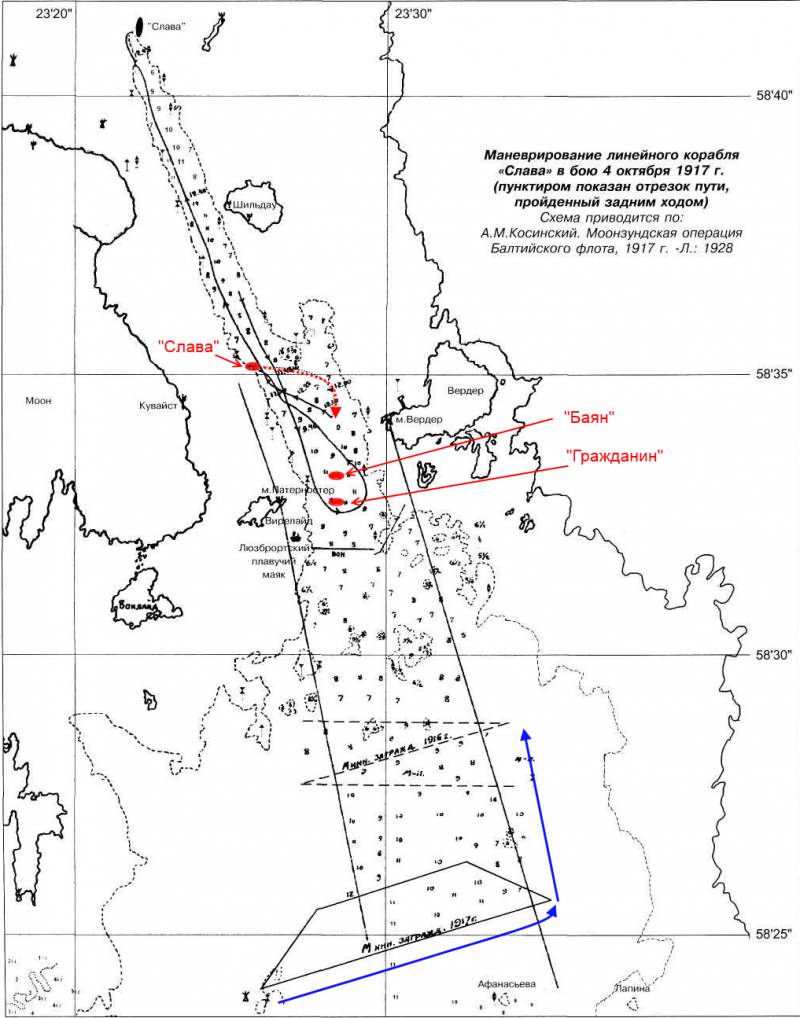
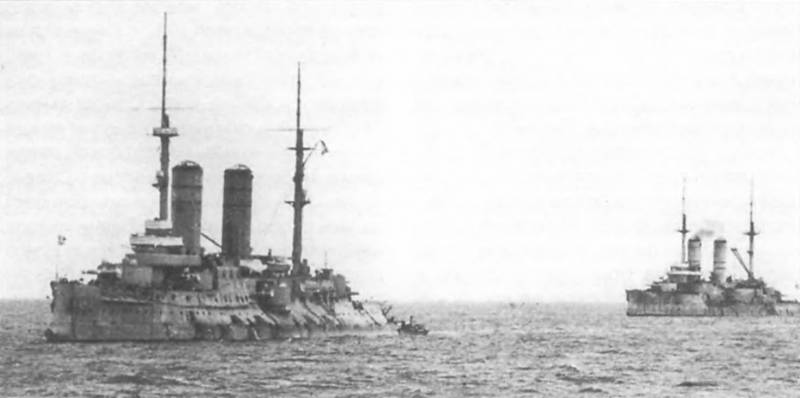
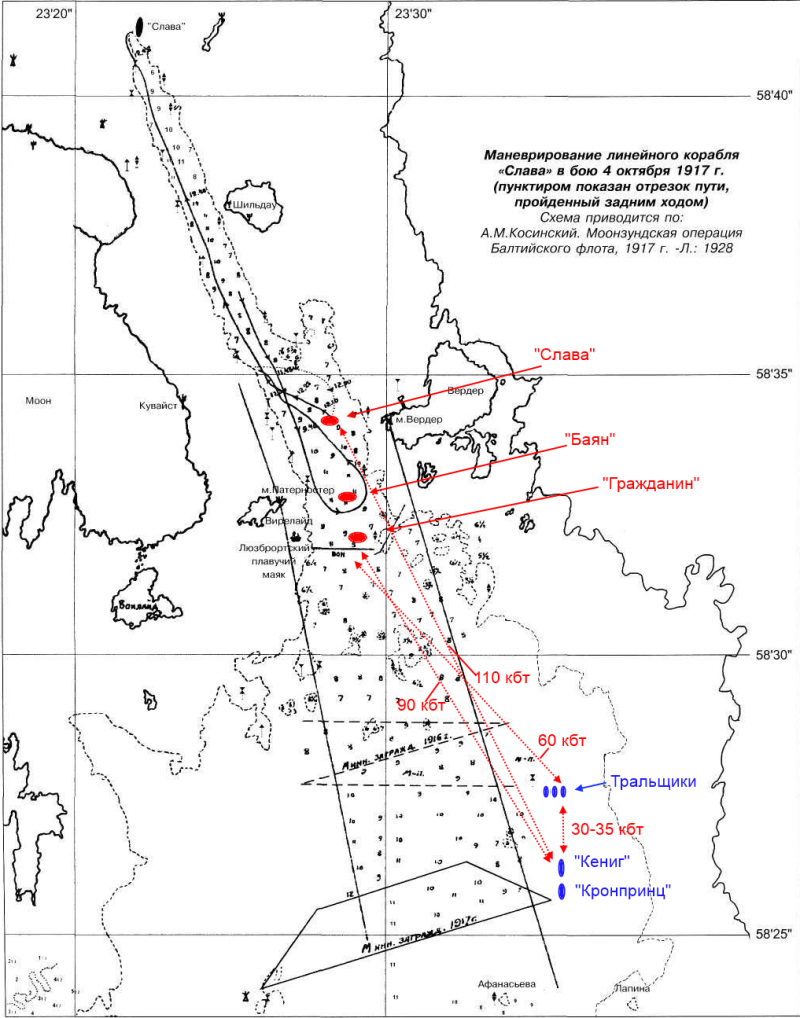
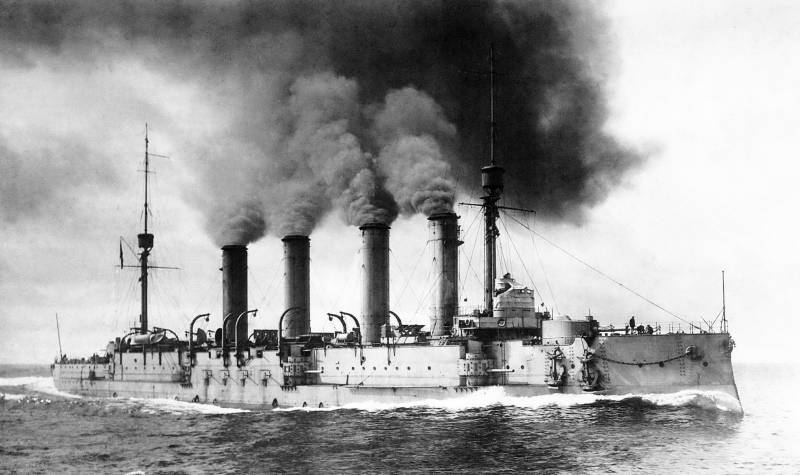
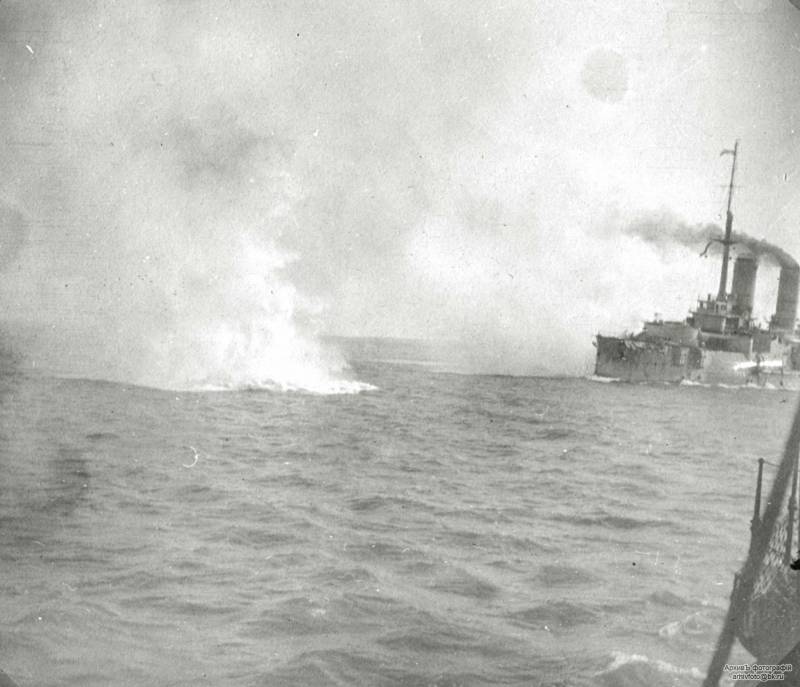
Information